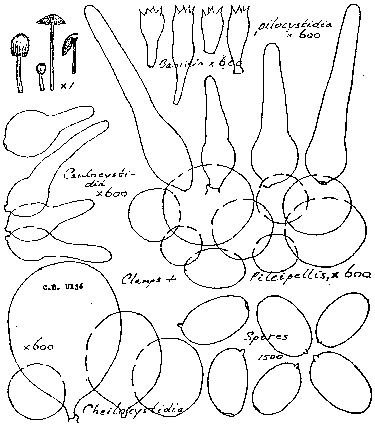Macroscopic features |
Closed pileus up to 10 x 9 mm, dark red-brown to ochre-brown at centre (Mu. 7.5 YR 3-4/4, 4/6, 10 YR 4/4, 5/3-4, 6/5, K. & W. 6E/F8, 6E7, 5C4), paler towards margin (7.5 YR 4/4, 10 YR 4-5/3, 6/4-6, 7/2-4, 2.5 Y 7.5/4 to 5 Y 6/1, K. & W. 5C/D4, 4A3); up to c. 22 mm wide when expanded. Lamellae free, up to 2 mm broad, white to blackish; L= 16-21, l= 1-3. Stipe 20-50 x 1.5-2.5 mm, whitish, pubescent. |
Microscopic features |
Spores [60,3,1] 9.4-12.8 x 6.0-7.6 µm, av. L= 11.1, av. B= 6.7 µm, Q= 1.55-1.80, av. Q= 1.65, ellipsoid to ovoid; germ pore eccentric, c. 1.8 µm wide. Basidia 18-40 x 8.5 -10.5 µm, 4-spored. Pseudoparaphyses 3-6 per basidium. Cheilocystidia mostly globose, up to 40 µm in diam., but also broadly ellipsoid, up to 40 x 25 µm. Pleurocystidia absent. Pileocystidia 50-90 x 13-20 µm, lageniform with tapering neck, 5-7 µm wide at apex. Sclerocystidia absent. Caulocystidia somewhat shorter and broader, 40-80 x 16-25 µm, lageniform with tapering to cylindrical neck and equal, sometimes slightly enlarged, 5-8.5 µm wide apex. Clamp-connections present. |
Habitat |
Solitary or gregarious in dry ditch, on humus and fallen branches. |
Remarks |
Macroscopically this taxon resembles C. callinus, but the fruit-bodies are smaller than in C. callinus and they grow (sub)solitary. Microscopically this species deviates in the absence of sclerocystidia, which are almost always present in C. callinus. The other microscopical characters are practically the same, with exception of the length of the pileo- and caulocystidia, which is greater in C. callinus. |

[Copyright © by Uljé]